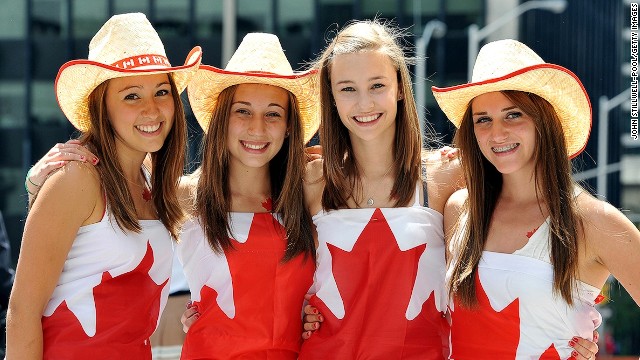
U.S.A
The United States is home to many cultures and a wide variety of ethnic groups, traditions, and values.Aside from the Native American, Native Hawaiian and Native Alaskan populations, nearly all Americans or their ancestors settled or immigrated within the past five centuries.Mainstream American culture is a Western culture largely derived from the traditions of European immigrants with influences from many other sources, such as traditions brought by slaves from Africa.More recent immigration from Asia and especially Latin America has added to a cultural mix that has been described as both a homogenizing melting pot, and a heterogeneous salad bowl in which immigrants and their descendants retain distinctive cultural characteristics.
Core American culture was established by Protestant British colonists and shaped by the frontier settlement process, with the traits derived passed down to descendants and transmitted to immigrants through assimilation. Americans have traditionally been characterized by a strong work ethic, competitiveness, and individualism, as well as a unifying belief in an “American creed” emphasizing liberty, equality, private property, democracy, rule of law, and a preference for limited government.Americans are extremely charitable by global standards. According to a 2006 British study, Americans gave 1.67% of GDP to charity, more than any other nation studied, more than twice the second place British figure of 0.73%, and around twelve times the French figure of 0.14%.
The American Dream, or the perception that Americans enjoy high social mobility, plays a key role in attracting immigrants. Whether this perception is realistic has been a topic of debate. While mainstream culture holds that the United States is a classless society, scholars identify significant differences between the country’s social classes, affecting socialization, language, and values.[ Americans’ self-images, social viewpoints, and cultural expectations are associated with their occupations to an unusually close degree. While Americans tend greatly to value socioeconomic achievement, being ordinary or average is generally seen as a positive attribute.
CANADA

Canada is more than its hulking-mountain, craggy-coast good looks: it also cooks extraordinary meals, rocks cool culture, and unfurls wild, moose-spotting road trips.
Sublime Nature
The globe’s second-biggest country has an endless variety of landscapes. Sky-high mountains, glinting glaciers, spectral rainforests and remote beaches are all here, spread across six times zones. It’s the backdrop for plenty of ah-inspiring moments – and for a big provincial menagerie. That’s big as in polar bears, grizzly bears, whales and, everyone’s favorite, moose.
The terrain also makes for a fantastic playground. Whether it’s snowboarding Whistler’s mountains, surfing Nova Scotia’s swells or kayaking the white-frothed South Nahanni River in the Northwest Territories, adventures abound. There are gentler options, too, like strolling Vancouver’s Stanley Park or swimming off Prince Edward Island’s pink-sand beaches.
Active Endeavors
Sip a café au lait and tear into a flaky croissant at a sidewalk bistro in Montréal; head to an Asian night market and slurp noodles in Vancouver; join a wild-fiddling Celtic party on Cape Breton Island; kayak between rainforest-cloaked Aboriginal villages on Haida Gwaii: Canada is incredibly diverse across its breadth and within its cities. You’ll hear it in the music, see it in the arts and taste it in the cuisine.
Cuisine (& Poutine)
Canada is a local food smorgasbord. If you grazed from west to east across the country, you’d fill your plate like this: wild salmon and velvety scallops in British Columbia, poutine (golden fries topped with gravy and cheese curds) in Québec, and lobster with a dab of melted butter in the Maritime provinces. Tastemakers may not tout Canadian food the way they do, say, Italian or French fare, so let’s just call the distinctive seafood, piquant cheeses, and fresh, seasonal fruits and veggies our little secret. Ditto for the bold reds and crisp whites produced from the country’s vine-striped valleys.
Cultural Flair
The arts are an integral part of Canada’s cultural landscape, from the International Fringe Theater Festival (the world’s second-largest) in Edmonton to mega museums like Ottawa’s National Gallery. Montreal’s Jazz Festival and Toronto’s star-studded Film Festival draw global crowds. And did you know Ontario’s Stratford Festival is the continent’s largest classical repertory theater? Even places you might not automatically think of – say St John’s or Woody Point – put on renowned shindigs (an avant-garde ‘sound symposium’ and a big-name writers festival respectively).
Why I Love Canada
by Karla Zimmerman, Author
I’m always blown away by Canada’s vastness, its enormous open landscapes. You can drive for hours in many areas and see almost no one. I love that Canada’s wildlife spotting is for real – moose, bears, whales – you will see them if you go looking. I love that the nation’s most popular restaurant – Tim Hortons – is a doughnut shop named after a hockey player. And I’m just going to come out and admit it: the more I’m in Canada, the more I appreciate rock band Rush.
Read more: http://www.lonelyplanet.com/canada#ixzz3TsN3qLq0
-
Free & Easy
- USA Program
- Canada Program
- Africa Program
-
Booking
Comments are closed.